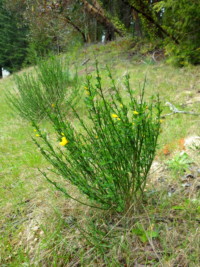Weeds 101: Scotch Broom
 Battling Scotch Broom
Battling Scotch Broom
Bloedel Reserve, just like any other landscape, has to deal with the consequences of weeds. Some weeds can be so troublesome that Washington state puts them on an official Noxious Weed List. The battle against noxious weeds is an ongoing fight at Bloedel Reserve. Fortunately, the Reserve has Tobin Tripp, our staff weed expert (along with his many other skills).
Don’t let its pretty flowers fool you! Scotch Broom (Cytisus scoparius) is a noxious weed that, at one time, was commonly found all over the Reserve. It poses a problem because it spreads aggressively, crowding out and replacing native vegetations and often forming large monocultures that replace desirable species. The seeds are also toxic to livestock and horses.
Most people are familiar with seeing it growing in abundance along the roadsides, with its dark green woody stem that can get from three to ten feet tall. There are few leaves on the stem which leave the predominant bright yellow flower and the seeds. The seed pods are brown, flat, legume-like in shape, and hairy with multiple seeds per pod.
 A Prolific Invader
A Prolific Invader
A single Scotch Broom plant can produce over 10,000 seeds per plant. Those seeds can remain viable in the soil from 30 to 80 years, creating a large seed bank that can build up in the soil and wait for more favorable conditions to produce new plants. At the Reserve, if small plants appear in the forest and go unnoticed for one season, they can produce enough viable seed to spread throughout the understory. In fact, we saw this happen in areas around the exit road bridge and in the forest west of the Sheep Shed field. It took a conjoined staff effort to search those areas and control the shrub manually.
Going, Going, Gone

Once Scotch Broom has become established, it is important to curb its seed production in order to keep the seed bank size down. The best methods of control are hand-pulling and cutting. For smaller plants, hand-pulling is easiest when the soil is moist. For larger stems, cutting right at or below soil level can be effective especially during the warmer months when less moisture is available for regrowth.
After Scotch Broom plants have been removed, the area should be managed for seedling emergence. Scotch Broom has a special affinity for establishing itself in disturbed soil. A portion of the dormant seed bank will take soil disruption as a cue to begin growing. So it is very important to disturb the soil as little as possible when removing the plants.
As with other noxious weeds, we don’t advise composting Scotch Broom, particularly their seeds, roots, or rhizomes. There is no guarantee that composting will completely destroy noxious weeds. Scotch Broom (and other noxious weeds like it) should be disposed of somewhere they cannot continue to grow. Often the best action is to bag them and put them in a garbage can.
— Content and photos provided by Tobin Tripp, Grounds & Horticulture Associate, and Darren Strenge, Moss Garden Specialist
SIGN UP FOR OUR ENEWSLETTER
Stay up to date on all of the events and activities taking place at Bloedel Reserve.

